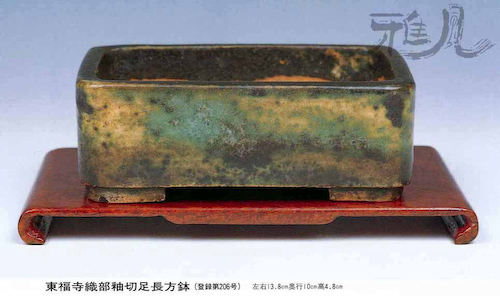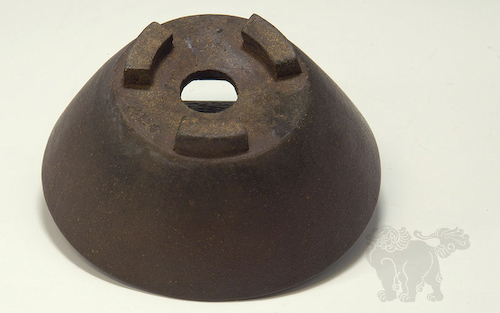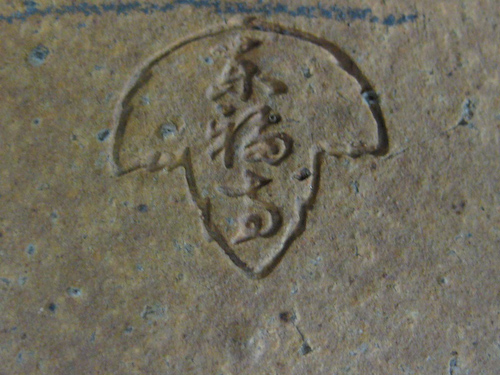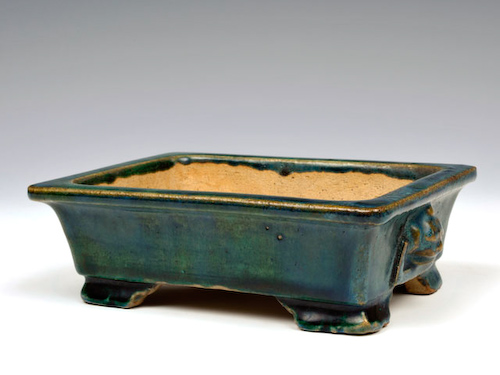Tags
What discussion of bonsai pots can be held without marveling at the work of Heian Tofukuji. He was born April 25, 1890 and unfortunately has now passed away. His son is also a potter; a few notes about that later.
As with many artist it was ironically after his death that his works began to attract attention and subsequently prices began to soar. Today a small single color pot will start at $600-800 and then quickly rise into the thousands and in some cases ten of thousands of dollars. While I was in Japan with three very good friends in 2008 (Jeff, Kenny and Boon) we were at the Green Club in Ueno Park and saw two of his pots that were $50,000 and $180,000 respectively. Yes those numbers are not mistakes. These were clearly for his larger works but even small pots can easily fetch $3-9,000.
I have now studied his pots for about three years and it has become quite easy to discern his pot before ever seeing the potter’s chop mark; more about his chop mark later. The reader should not attribute this to my keen eye, but rather to Tofukuji’s artistic ability to be so unique that his glazes can be easily recognized even though many have attempted to replicate them including his son; however, with little success might I add.

Tofukuji (Photo copyright Higuchi Takeshi for most images this post)
The above photo is my absolute favorite. If you are not familiar with his pots you might ask “what is so special about this pot?” Many years ago when I first saw this pot, I also thought “so what.” I must admit like many bonsai enthusiast in America it takes time to truly appreciate incredibly well designed and glazed bonsai pots.
I have seen many photos of this pot and have searched many Japanese web sites to attempt to purchase it. I’m sure it is stored away in a private collection, but my search continues.
This pot reminds me of a foggy day in a forest. Deep in texture and color, I have often gazed at this pot attempting to understand Tofukuji’s intent for this pot. This pot has depth, beauty, and wonderful form.

Tofukuji upright pot
This incredible pot is actually for sale at Yorozuen.jp for a small sum of $9,800. What can barely be seen in this photo is how the right most green glaze reaching for the bottom of the pot is repeated on the interior left side of the pot; note it is hard to see in this photo. How inventive some 80 years ago that Tofukuji would create a stylized treatment of this pot by including glaze on the interior of a pot where if used for bonsai it would be completely hidden from the observer.
This is quintessential Tofukuji. A pot where if used in bonsai would hold a secret only known to Tofukuji and the owner of the pot. Like many of his pots today they are sans tree and stored carefully in a cherished collection.

Carefully study this very unique Tofukuji glaze!
This mottled pink and green glaze is a beauty to behold. How this glaze was done is beyond me and unfortunately many bonsai potters. To me it isn’t just the color but also how the glaze was applied. There always seems to be something mysterious about his colors and patterns used in his glazes and this is what makes his pots so recognizable to many who collect his them.

Tofukuji
Notice the similarity in the above two pots. The green glaze is very similar but now with a very different feel. The first pot is brighter whereas the lower pot is more brooding and has a much darker feel.
Both pots have outstanding shape. Even though Tofukuji made numerous large pots, he seemed to specialize in shohin pots. Perhaps he innately understood the value of his pots, even though most did not when he was alive, and understanding the long term value he made many smaller pots so that they could be affordable. It is important to note that at the time of his life bonsai principally consisted of very large trees. Even a short ten years ago shohin sized trees were significantly less expensive than larger trees. This simply isn’t true any more as shohin prices have risen dramatically in Japan and subsequently in the U.S. as well.
Let me state before the next two photos that my wife and I are extremely pleased, or perhaps proud, that we were able to acquire this pot last year. We purchased it through our very good friend Yoshihiro Nakamizu who owns a shop just outside of Tokyo. Yoshi as his friends call him has a wonderful bonsai site at http://www.j-bonsai.com. I began buying things through Yoshi in 1993 and finally met him in 2008 when he was kind enough to take a group of us around to several bonsai artist homes. In late 2007, Yoshi and I came to an arrangement where he acts as an intermediary for my wife and I in purchasing pots, suiseki, dobans and the like. In a future post I will speak more about Yoshi, but let me add without him our collection without a doubt would be significantly less than it is today.

Tofukuji non-glazed pot in the collection of Sam and KJ
This simple but elegant pot is barely three inches tall but is exquisitely made. This pot has never been used and is one of the highlights of our collection. We are fortunate to own four of Tofukuji’s pots; more on these pots in a future post.

Tofukuji chop mark
Tofukuji had numerous chop marks, and this mark can be seen in the bottom left of the above photo. The clay used for this pot is not often seen anymore. Perhaps it was unique to the area in which he lived. A similar clay can be seen in Ryuen Kamiya’s pots; a future post on Ryuen’s pots will be posted.

Tofukuji chop mark in the form of a leaf
One of his best known chop marks is shown above. I must also state this is one of the most forged chop mark of any Japanese bonsai pot period. In fact there are so may forgeries of his pots that it has diminished the value of his pots in recent years. If you are going to buy one of his pots, which I strongly recommend, you must be very careful to buy from a reputable dealer so that you don’t end up paying a great deal for a pot likely worth less than $100.

Tofukuji chop mark
This chop mark in this form is not seen as often. Notice that it is the same Kanji script that is in the leaf design and as shown in our pot without being inside a leaf or oval design.

Tofukuji chop mark in a square design
This design was also widely used. My research to date has not uncovered why this doesn’t include the kanji characters often seen in his other chop marks so I hope to discover one day why.
Let me leave you with two more photos of similar design incorporating a lion’s head.

Tofukuji pot with lion's head

Tofukuji pot with lion's head
If you are new to Tofukuji’s pots, I hope this post will encourage you to seek out and study both his pot designs and glazes. His pots are in numerous books from Japan with perhaps the quintessential book on his pots being:

Tofukuji Pot Book
This book lists for 3.799 Yen or can currently be purchased off of eBay from Nakanishi Chinshouen; an owner of a bonsai store in Japan. If interested hurry and use the link to purchase this book now. Search for item number 180401724857. It is priced at $55 including shipping which is a fair price. Note that KJ and I have purchased several items from Nakanishi’s site so I highly recommend them.
If the eBay copy is sold by the time you read this you can purchase a copy of the book from Yoshoen’s site by visiting this link:
http://www.y-bonsai.co.jp/cgi-bin/item_detail.asp?ItemID=120101000058
Even if you don’t desire to collect his pots due to the expense, I still recommend that you study his designs and glazes as they are some of the finest ever created for bonsai. His sons pots can also be found at substantially lower prices ($100-1,000).
If you make it to Japan and attend Kokufu you are likely to see his pots for sale at the Green Club in Ueno Park. Happy hunting and take lots of money!

Nice blog Sam and KJ. I think I’m going to buy one of those books too. One of these days I’ll have a tofukuji pot. I’m sure I’ll bring some back from Japan in the future.
Beautiful blogsite Sam with very interesting content. I look forward to revisiting.
Thank You Sam & KJ. Your site is very informative. It help me decide where and from who to buy my first Yusen pot. My Thanks to a great blog !
Frank you are welcome. Happy New Year!
You may well already know this but the second pot above (upright) is in the style of Oribe. Furuda Oribe was a nobleman who lived from 1544 to about 1615. He began a tradition of whimsical pottery, usually for the tea ceremony, that Tofukuji has capured in his pot. It is typical to decorate the inside of a container when building in the Oribe style. I collect oribe pieces — they are still being made, but those of real interest were typically made 75 years or longer ago. Edo era pieces are the most desireable — and the most expensive.
The green is a copper/oak ash glaze that is fired in a very oxygen rich environment, typically an anagama kiln. If fired using reduction (oxygen starved) the glazed turns red or orange.
Ken
Hello Sam,
Is the maple leaf shape made with a stamp, or by scratching into the clay? Thanks, Tony
I’m certain it is a stamp as the chop is too consistent. Also, if you check out his book (listed on the site) you will see numerous hanko (seal) markers made out of various materials.
Sam
Hi their from Lester, this was very interesting to learn about these old bonsai pots. I’ve been collecting them to use for my old bonsai since the early 70’s. I found a large one that is three feet square blue in color that some one had at a flea market. They thought it was a old japanese table and the two legs were broken and the tile top was cracked. I got it for a song and a dance so to speak cost me $250.00. I bought it with out saying a single thing and ran home carrying my new baby with me. It was made some time in the early 1790-1830 period. But I just wanted to say I think I found in my pile of old pots two large bonsai pots made by this maker Tofukji that are around two feet square and a large oval one the chop seal sure looks like yours alot. I got them from a antique pottery dealer in Phila, Penn. back in early 1970’s they cost alot back then around $3,000.00 for the pair they are truly amazing to look at they just sit on display in my home. You very rarely see such work around these days.
Pingback: What a Crack Pot! « Peter Tea Bonsai
Pingback: Revue du bonsaï web - septembre 2012 n°7 - actubonsai
Pingback: Web bonsai review #7 - september 2012 - actubonsai